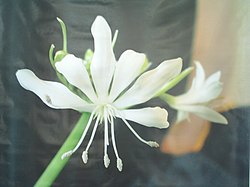Top Qs
Timeline
Chat
Perspective
Plagiolirion
Genus of plants From Wikipedia, the free encyclopedia
Remove ads
Plagiolirion is a monotypic genus in the family Amaryllidaceae endemic to Colombia.[1] It has only one known species, Plagiolirion horsmannii,[1] which is rare in the wild and was thought to be extinct until it was rediscovered in the Río Cauca Valley in 1989.[3]
Remove ads
Description

Vegetative characteristics
Plagiolirion horsmannii is a bulbous,[4][5] perennial herb with subglobose[3] or ovoid,[4][6] tunicate, 5–6 cm long, and 5–5.5 cm wide bulbs[3] with fleshy roots.[4] The bulbs have offsets at the base.[3][7]
Generative characteristics
The scapose, umbellate inflorescences with a terete, solid,[3] erect,[8] glaucous green,[6] 49–66 cm long, and 0.5 cm wide scape,[3] bears 10–41[3] white,[5][9] zygomorphic,[10] inodorous, protrandrous, pedicellate,[4] 2.5–3 cm long,[3] and 3–4 cm wide flowers.[9] The thin pedicels are 1.5–2 cm long.[3]
Cytology
The diploid chromosome number of Plagiolirion horsmannii is 2n = 46.[3][10]
Remove ads
Taxonomy
The genus and species were first described by John Gilbert Baker in 1883.[4] The genus is placed in the tribe Eucharideae.[11]
Etymology
The generic name Plagiolirion, from plagios meaning 'oblique' and leirion meaning 'lily',[7] is derived from the floral morphology.[6] The specific epithet horsmannii honours Fred Horsman,[8] who imported the species to Colchester, United Kingdom.[9][6][7]
Ecology
Habitat
It occurs in the Colombian Andes.[7]
References
Wikiwand - on
Seamless Wikipedia browsing. On steroids.
Remove ads


